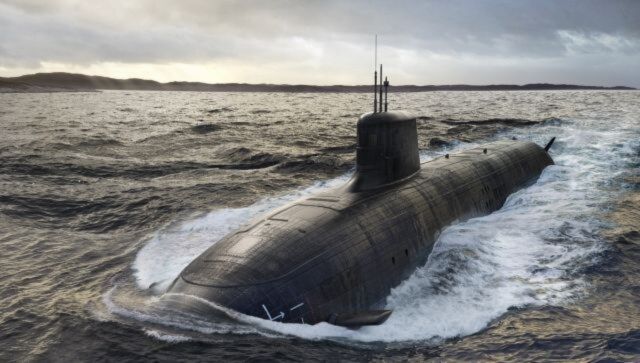The Indian Navy’s undersea combatant arm has been grappling with a significant disparity between its ambitions and capabilities as the proposal to procure a minimum of six nuclear-powered attack submarines (SSN) remains pending government approval for almost four years, creating a challenging situation for the navy. With the lease of the Russian Akula class nuclear-powered submarine concluding in 2021, the Indian Navy presently lacks any SSNs in its fleet. To address this critical gap, India has initiated discussions with France, exploring the possibility of a collaborative project to construct the required six SSNs. China boasts an extensive submarine fleet comprising over 70 submarines, encompassing seven nuclear ballistic missile submarines (SSBN), 12 nuclear attack submarines (SSN), and more than 50 diesel attack submarines (SSKs). On the other hand, India’s conventional submarine fleet mainly dates back to the 1980s, raising concerns about its ageing capabilities. To address the increasing prowess of the Chinese People’s Liberation Army Navy (PLAN), India recognizes the significance of nuclear-powered submarines. This realization has led to reports that India has put its plans for building a 65,000-ton Indigenous Aircraft Carrier (IAC)-2 on hold, prioritizing the development of its SSN project instead. SSNs are considered the underwater equivalent of fighter jets, and their integration into the Indian Navy is seen as a critical step to maintaining strategic balance and countering potential threats. “SSNs are a game changer. They are powerful platforms with stealth and unlimited endurance. They can remain underwater indefinitely and operate far away from the port for long periods and at high speeds. They can move along as part of the carrier battlegroup. Armed with long-range missiles, they can change the shape of maritime battle,” a former Indian Navy submariner Commodore Anil Jai Singh told the EurAsian Times. The SSN, in comparison to the slower and shorter-ranged diesel submarine, possesses superior reach, endurance, and speed. It has the capability to stay submerged for extended periods, whereas conventional diesel engine-cum-battery propelled boats, even those equipped with Air-Independent Propulsion (AIP), can only remain submerged for hours or days. Deep beneath the waters, the SSN’s stealth makes it challenging to detect, and its remarkable speed allows it to outpace and overtake most other submarines or warships, if necessary, a feat that diesel submarines cannot achieve. SSNs have historically played crucial roles in protecting carrier battle groups and tracking enemy SSBNs, while also serving as versatile platforms for anti-ship operations, land-attack missions, and surveillance activities. In 2019, India entered a US$3 billion deal with Russia for acquiring another nuclear-powered Akula class attack submarine. However, due to the ongoing Russia-Ukraine conflict, the lease’s commencement is likely to miss its deadline of 2026. On the other hand, the development of indigenous SSNs is contingent on government approval, and if granted, it is estimated to take another 10-15 years before the first one becomes combat-ready. Realistically speaking, the first domestically-built SSN is expected to join the Indian Navy’s fleet by 2040. The Indian Navy has received in-principle approval for six SSNs and awaits the go-ahead from the Cabinet Committee on Security (CCS) to initiate the construction process. In July, the Bhabha Atomic Research Center (BARC) and the Electronics Corporation of India Limited (ECIL) joined forces, signing an agreement to develop 11 types of control systems and multifunction consoles. This collaboration aims to enhance the efficiency of SSN-related tasks and bolster India’s nuclear triad, which supports the established nuclear warfighting doctrine. Currently, India possesses two nuclear-powered ballistic missile submarines (SSBNs), which primarily serve as instruments of the country’s nuclear deterrence and cannot be deployed for tactical missions. However, the introduction of SSNs plays a vital role in countering numerically superior navies. These submarines possess the capability to stealthily track and follow targets, and their near invulnerability makes them a formidable weapon in the nation’s arsenal. A prime example of their strategic deployment is India’s only Russian Akula class submarine, renamed INS Chakra, which was stationed on the eastern side of the Indian Ocean during a past decade’s border standoff with China, showcasing their versatility and significance in bolstering India’s maritime security. The Indian nuclear-powered submarine program has faced delays due to bureaucratic challenges, while the People’s Liberation Army Navy (PLAN) of China has been making significant advancements to bolster its undersea capabilities. A US Naval Institute assessment reveals that China’s current Shang class SSN exhibits noise levels comparable to Soviet designs from the 1970s. However, if the PLAN manages to deploy super-quiet SSNs equivalent to the best US and Russian submarines, it would mark a significant strategic shift. Such advanced capabilities would not only enhance China’s ability to defend itself on the open ocean but also enable the country to threaten US naval forces well beyond the first island chain, granting transoceanic reach without the need for extensive logistical support or overseas bases as required by a carrier strike group. Since 2009, the PLAN’s presence in the Indian Ocean has been steadily growing, with a primary focus on countering piracy and safeguarding its commercial interests. China has been actively deploying Sea Wing Underwater Unmanned Vehicles to gather valuable data on currents, acoustics, and the maritime environment, aiding its submarines in charting navigational courses. Since 2017, the deployment of submarines, survey ships, and hydrographic vessels in the Indian Ocean by the PLAN has become a regular occurrence. The increasing presence of Chinese state-run hydrographic ships and survey vessels is believed to pave the way for potential future deployments of Chinese SSBNs and SSNs in the region.
The nuclear-powered attack submarines have historically played crucial roles in protecting carrier battle groups and tracking enemy SSBNs, while also serving as versatile platforms for anti-ship operations, land-attack missions, and surveillance activities.
Advertisement
End of Article


)

)
)
)
)
)
)
)
)



